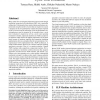Free Online Productivity Tools
i2Speak
i2Symbol
i2OCR
iTex2Img
iWeb2Print
iWeb2Shot
i2Type
iPdf2Split
iPdf2Merge
i2Bopomofo
i2Arabic
i2Style
i2Image
i2PDF
iLatex2Rtf
Sci2ools
ISCA
1996
IEEE
1996
IEEE
Performance Comparison of ILP Machines with Cycle Time Evaluation
Many studies have investigated performance improvement through exploiting instruction-level parallelism (ILP) with a particular architecture. Unfortunately, these studies indicate performance improvement using the number of cycles that are required to execute a program, but do not quantitatively estimate the penalty imposed on the cycle time from the architecture. Since the performance of a microprocessor must be measured by its execution time, a cycle time evaluation is required as well as a cycle count speedup evaluation. Currently, superscalar machines are widely accepted as the machines which achieve the highest performance. On the other hand, because of hardware simplicity and instruction scheduling sophistication, there is a perception that the next generation of microprocessors will be implemented with a VLIW architecture. A simple VLIW machine, however, has a serious weakness regarding speculative execution. Thus, it is a question whether a simple VLIW machine really outperfor...
| Added | 07 Aug 2010 |
| Updated | 07 Aug 2010 |
| Type | Conference |
| Year | 1996 |
| Where | ISCA |
| Authors | Tetsuya Hara, Hideki Ando, Chikako Nakanishi, Masao Nakaya |
Comments (0)

